The people of Papua New Guinea (PNG) live in the Southwestern of the Pacific Ocean on an Island found to be so productive. Their capital city is known as Port Moresby and is located in the southeastern part of Oceania Island. Melanesians were the first people to have settled in Papua New Guinea, and they are believed to have explored the Island around 40,000 years ago. Most of them settled in the highlands before they spread to the other part of the Island. The people of Papua New Guinea attained its independence from the British in the year 1975. History reveals that several colonies were interested in colonizing Island, and they include Australia, Japanese, and German. One of the reasons why the colonies scrambled for Papua New Guinea was the availability of natural resources such as gold and a conducive climate for their plantations. The colonies also settled on the Island for missionary work (O’Donoghue 792). The spread of World War II across the European continent accelerated more conflicts between different nations, and as a result, Japan and the British conquered Rabaul in Papua New Guinea, the Germans troops established their plantations in Madang, then Australian troops expanded their territories in Papua.
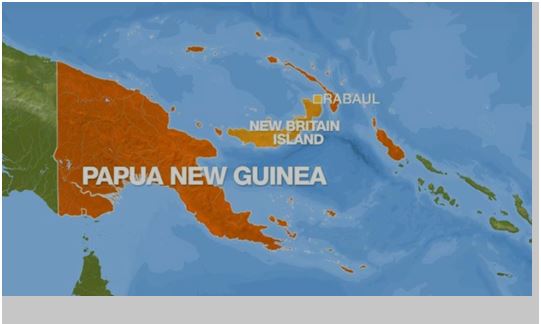
Geographical position of Papua New Guinea Island
The region of Papua became the main headquarter of the economic, political, and social activities of New Guinea Island. It gave the Australia advantage to control the Island and later established its administration in Port Moresby, a big city still found in the national city of Papua New Guinea up to date (May 47). The purpose of my research is to learn the magnificent cultural diversity in New Papua Guinea and how it led people to get adapted to the modern world. At the end of my research, I will be able to understand how culture has touched modernization and globalization. Therefore, capable of changing and transforming most of the communities.
Literature Review
I was not the first person to have got interested in Papua New Guinea, but well-known Anthropologists have also conducted their anthropological research in Papua New Guinea. It showed the land of Papua New Guinea was a hot spot with more than a thousand ethnic groups who speak different indigenous languages. Nicholas Miklouho-Maclay was the first Anthropologist to settle on the Island and studied the emergence of Papuans, who were among the earliest ethnic groups. Maclay is believed to have settled in the Inland at the age of twenty-five and carried a research on the development of racial groups in Oceania areas (Govor & Manickam 230). Margaret Mead is also another popular anthropologist who has taken several studies in Papua New Guinea. One of her works a book by the name “Growing Up in New Guinea (1930),” which she based her research on the cultural construction of gender (Sulliva 185). These two anthropologists made me believe that the Island has immense cultural and biological diversity.
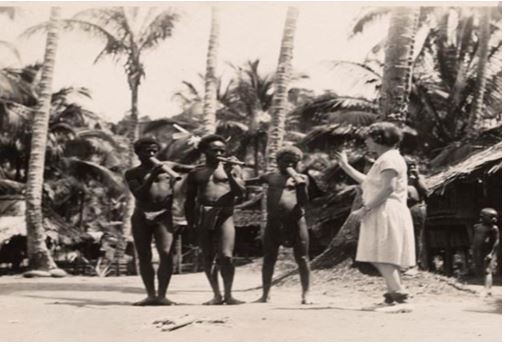
Anthropologist Margaret Mead in Papua New Guinea in 1930s
History revealed that the ethnic groups in Papua New Guinea are believed to have originated from early indigenous people who include the Melanesians, Polynesians, Negritos, Micronesians, and Papuans (Govor & Manickam 238). I found that Papua New Guinea remains to be one of the Islands in the continent of Oceania that has a heterogeneous population of different ethnic groups. The study of anthropology has also mentioned various cultural aspects that have developed from the interbreeding of multiple communities in Papua New Guinea. These aspects are such as language, traditions, and customs. The earliest ethnic group to settle in Papua New Guinea was the Papuans ethnic group who came with the Papuan language. In terms of geographical location, the majority of ethnic groups in Papua New Guinea migrated and settled to the Southern highlands. Their settlement was contributed to their interest in subsistence farming along the highlands and domesticating animals (Denham et al. 48). The highlands were covered with plenty of vegetation that attracted most of the communities to start practicing hunting.
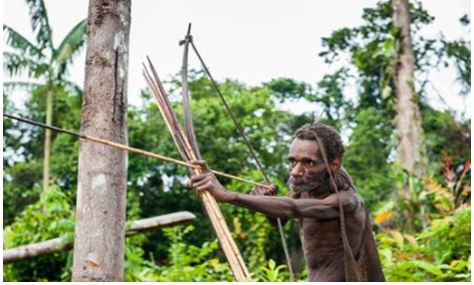
Papua New Guinea hunter
Papua New Guinea Highlands became ethnographic regions where most communities are culturally homogenous and share autochthonous traits. The communities include the Papuans, Huli, Mian, Kwoma, Duna, Motu, Fore, and Tolai (Schwoerer 320). All these ethnic groups are identified by their ancestral origin. Through the knowledge of anthropology, I realized how these ethnic groups are culturally oriented and try to come up with ideas about how they are still stuck to the indigenous religious practices and leadership. Apart from noting that the ethnic groups valued their ancestral origins, I was capable of tracing migration routes into the Papua New Guinea Island. A good example of the Fore ethnic group who migrated from Northeast and settled along the highlands of Kratke, Wanevinti Mountains, and Lamari Rivers. The vegetative patterns of migration allow some Fore communities to settle over the landscape and in thick forests (Schwoere 320). Due to linguistic affinities, the Fore language emerged from the earliest Papuan languages.
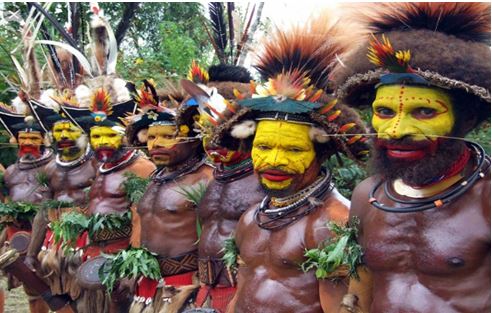
The Fore ethnic group
One interesting this about the Fore was they had a residential unit known as a hamlet. Their cultural practices were similar to most of the ethnic groups in Papua New Guinea. Most communities developed separate domestic units for men, women, and children. Men had their special communal houses, while women were also given special dwelling place where they would stay there during the period of menstruation and the time of giving birth. We have other communities whose men embraced the idea of staying together with their family members. As a result, it led to the formation of larger aggregated villages. Every community was encouraged to interbreed with other ethnic groups, which led to the increase of population in PNG. In most parts of the highlands, the common economic activities were substance farming, domesticating animals, and hunting. Most communities were growing horticultural and garden crops such as Sweet potato, beans, bananas, cabbages, pumpkins, onions, and peanuts (Denham 46). From History, most of the foods grown in highland were brought by colonizers. Pig husbandry was also part of economic activities, and a community with many pigs was considered wealthy. Some of the ethnic groups in Papua New Guinea used pigs as pets.
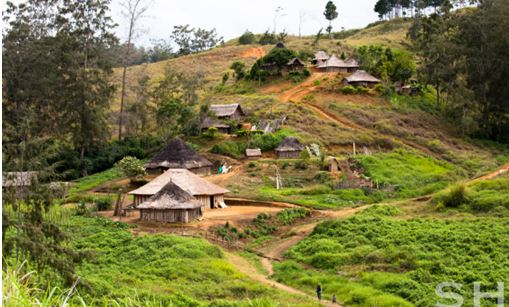
Papua New Guinea Highlands
Another traditional norm I found was valued as cultural practice in Papua New Guinea was a division of labor. Men were assigned the task of building houses and fencing village boundaries. Falling trees to pave space for creating new houses and gardens was also work for men. On the other side, women had the task of clearing and burning the bushes. They also prepared the gardens, cultivated, harvested, and transporting crops. Just like most cultures, women were supposed to take care of the young at home, look for firewood, and cook for the family. Kinship was an essential cultural practice in Papua New Guinea, and it was hierarchical. The largest kin-based group in most ethnic groups was the clan, which was headed by a chief, and it consisted of closely related members who believed to have a common ancestor and lived in close proximity to each other. The anthropologists who have taken their research in Papua New Guinea and defined “the term “chief” as a traditional Polynesian leader who uses exercise either temporal or priestly powers. In Papua New Guinea, chieftainship was typically characterized by seniority and titles in most communities” (Feinberg, 276). The practice of animism was also common among communities like Fore. It involves believing that a creature, an object, or a place can possess a distinct spiritual essence. Ceremonial events such as marriages brought most ethnic groups together and improved socialization. Polygamy was also widespread in Papua New Guinea, and according to my research, and it was encouraged due to the fact that men were few as a result of deadly disease Kuru (Schwoerer 318).
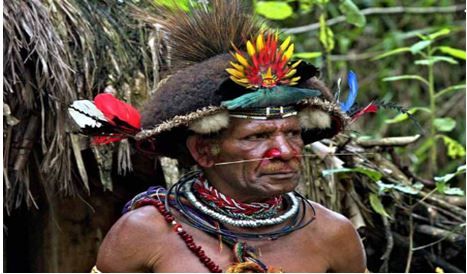
Papua New Guinea Chief
Kuru was a fatal disease caused by cannibalism, a cultural practice of some of the ethnic groups in Papua New Guinea. Cannibalism involved consuming the body parts of the dead. Men could hunt the head of the deceased and eat the brain as part of funeral rituals. The rituals included displaying the dead body to the public. Women would eat the flesh of the dead because they believed it would promote fertility. Men suffered from Kuru disease and died more than women because they valued death rituals, thus get into cannibalism more than women. Witchcraft and sorcery were accepted in Papua New Guinea, and some communities attributed most of the deadly diseases such as Kuru to witchcraft, natural spirits, or sorcery. According to Schwoerer 318, scientists started discouraging the two cultural practices, cannibalism and headhunting, because they discovered that consuming human flesh was the leading cause of deadly diseases. The most ethnic group believed in life after death. Elderly men took part in divination practices and sometimes were referred to as the “dream men.” They were considered authoritative, heal deceased people, solve conflicts, and maintained peace in communities.
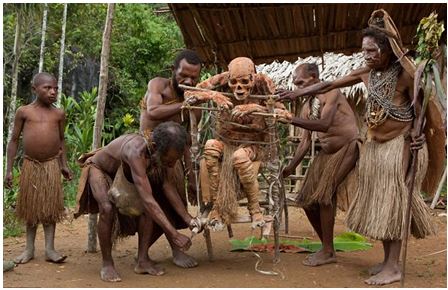
Cannibalism in Papua New Guinea
Setting and Background
The ethnic groups found in Papua New Guinea made me believe it was the best place to carry my anthropology research work. The area is believed to have magnificent cultural diversity, and several anthropologists have taken their studies in Papua New Guinea. Doing my study in Papua New Guinea is a very good example of a long term study that is encouraged by anthropology. Long term study or research allows us to search for enough information, interact with many audiences, and, most importantly, achieve the required goals. It required expenses as follows.
Transportation both on-air and ground $150,000.00
Accommodation: $100,000.00
Equipment and materials to be used in area study: $25,000.00
Food: $50,000.00
Salary: $70,000.00
Pocket money: $10,000.00
Total expenses required: $355,000.00
Methodology and Methods
By assimilating some of the cultural practices in Papua New Guinea helped me to interact and learn a lot of different traditions and customs of the ethnics groups. Most ethnics groups were accommodative and trusted me. Through participant observation, it helped me collect information that was helpful for my research. Places where it would take less time to interact with my audiences, it was good to use interviews. Learning the language of my subject helped me to have a direct conversation with my audience. The use of checklists and questionnaires did not work as I expected because most of my subjects in the villages were a bit illiterate. I did not want to collect the wrong information. Participant observation worked the best to help me collect first-hand knowledge needed for my research work. The method allowed me to get closer to the informants, observe and record information about their lives
Expected Findings and Analysis
Papua New Guinea Highlands is one of the ethnographic regions where most communities are culturally homogenous and share autochthonous traits. Various cultural, social-political, and economic organizations in Papua New Guinea developed out of cultural diversity (May 310). Anthropological studies have helped various communities to understand some of the societal problems that require education knowledge. Like the practice of cannibalism led to scientific research to discover the cure of deadly disease, Kuru was caused by consuming the brain of death. I think some cultures in Papua New Guinea developed due to the failure of the institutional system. If the society had learned about the consequences of eating the dead, nobody would practice cannibalism. The government failed to eradicate “primitivism” among the communities by not promoting education. The data collected showed that very few people do value education. The distinct forms of culture that have improved include dance, body paint, music, and weapons. I think Papua New Guinea has tried to engage itself in a meaningfully in globalization. My research was good evidence that the study of Anthropology is helping understand the culture and the nature of being human.
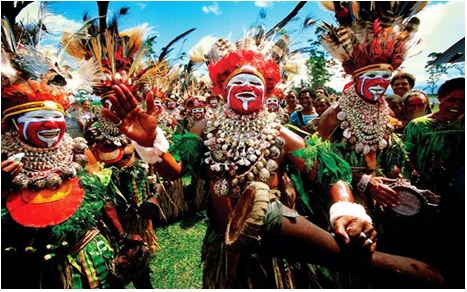
Papua New Guinea cultural practice
In my conclusion, I think some of the cultural practices in Papua New Guinea were weird and primitive. I supported the work of anthropologists because they tend to make us believe that every culture is essential to society. Still, I did not support cultural practices such as cannibalism and headhunting. Despite the ethnic groups in Papua New Guinea experiencing consequences out of such cultural practices, some of the communities continued practicing them. However, anthropological studies in Papua New Guinea have changed and transformed most of the communities. The country has maintained a robust democracy and active redistributive elements of culture (May 323). The world views the country more differently, unlike in the past. Lastly, my research will let me learn and come with a good definition of culture. My project was important to identify some of the characteristics of culture, including the fact that culture can be learned and shared. By engaging in a meaningful globalization, the people of Papua New Guinea have absorbed and shared new cultural practices that have enabled them to get adapted to the modern world. The country has been incorporated into the global economy, and thus it has formulated its policies to establish a stable government to accommodate its population. Through globalization, the country has also tried to eradicate social issues such as crime, unemployment, poverty, and illiteracy (May 315).
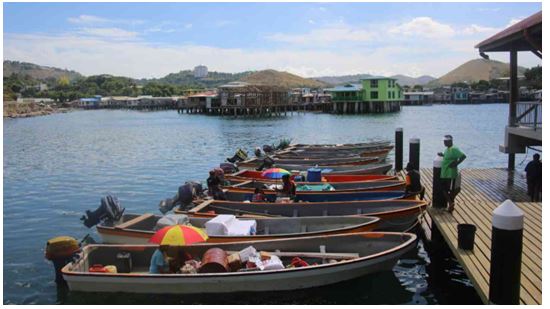
Current Papua New Guinea 2014
Work Cited
Denham, Tim, et al., editors. “Domesticatory Relationships in the New Guinea Highlands.” Ten Thousand Years of Cultivation at Kuk Swamp in the Highlands of Papua New Guinea, vol. 46, ANU Press, Australia, 2017, pp. 39–50. JSTOR,
Govor, Elena, and Sandra Khor Manickam. “A Russian in Malaya.” Indonesia & the Malay World, vol. 42, no. 123, May 2014, pp. 222–245. EBSCOhost, doi:10.1080/13639811.2014.911503.
Feinberg, Richard. “Nukumanu Kinship and Contested Cultural Construction.” Journal of the Polynesian Society, vol. 118, no. 3, Sept. 2009, pp. 259–292. EBSCOhost, search.ebscohost.com/login.aspx?direct=true&db=aph&AN=44371137&site=ehost-live.
“From promise to crisis: a political economy of Papua New Guinea.” State and Society in Papua New Guinea: The First Twenty-Five Years, by R. J. May, ANU Press, 2004, pp. 302–323. JSTOR,
May, Ronald. “Papua New Guinea: Issues of External and Internal Security.” Security Challenges, vol. 8, no. 4, 2012, pp. 47–60. JSTOR,
Sullivan, Gerald. “A Four-Fold Humanity: Margaret Mead and Psychological Types.” Journal of the History of the Behavioral Sciences, vol. 40, no. 2, Spring 2004, pp. 183–206. EBSCOhost, doi:10.1002/jhbs.20001.
Schwoerer, Tobias. “Sorcery and Warfare in the Eastern Highlands of Papua New Guinea.” Oceania, vol. 87, no. 3, Nov. 2017, pp. 317–336. EBSCOhost, doi:10.1002/ocea.5173. O’Donoghue, Tom. “Colonialism, Education and Social Change in the British Empire: The Cases of Australia, Papua New Guinea and Ireland.” Paedagogica Historica, vol. 45, no. 6, Dec. 2009, pp. 787–800. EBSCOhost, doi:1
Delivering a high-quality product at a reasonable price is not enough anymore.
That’s why we have developed 5 beneficial guarantees that will make your experience with our service enjoyable, easy, and safe.
You have to be 100% sure of the quality of your product to give a money-back guarantee. This describes us perfectly. Make sure that this guarantee is totally transparent.
Read moreEach paper is composed from scratch, according to your instructions. It is then checked by our plagiarism-detection software. There is no gap where plagiarism could squeeze in.
Read moreThanks to our free revisions, there is no way for you to be unsatisfied. We will work on your paper until you are completely happy with the result.
Read moreYour email is safe, as we store it according to international data protection rules. Your bank details are secure, as we use only reliable payment systems.
Read moreBy sending us your money, you buy the service we provide. Check out our terms and conditions if you prefer business talks to be laid out in official language.
Read more